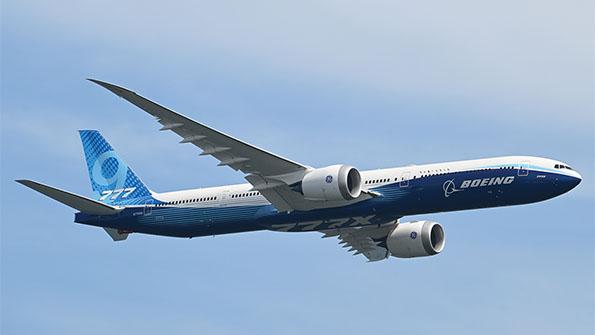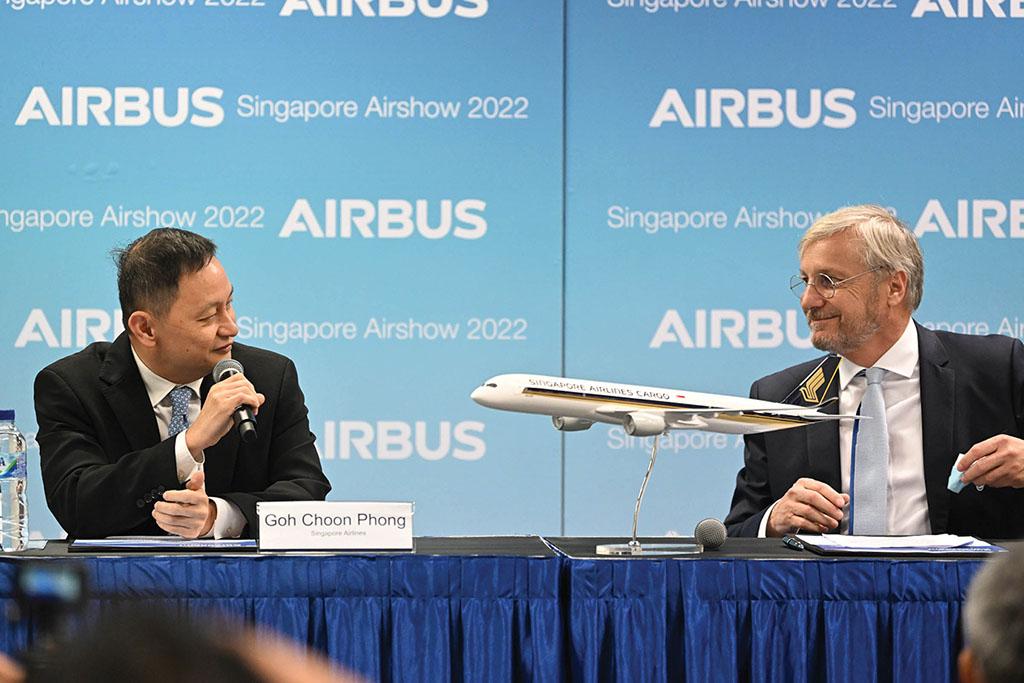
In normal times, Singapore Airlines’ decision to convert a letter of commitment for seven Airbus A350F freighters into a firm order would have generated only passing notice at a major air show. But at the show here in mid-February, the announcement took center stage—thanks to the absence of almost any other major deals.
If commercial activity and attendance at this year’s Singapore Airshow were an accurate reflection of the global state of the commercial aerospace industry, there would be much to worry about. The slimmed-down event drew an estimated 13,000 trade visitors—compared with 30,000 in 2020, which took place in the early days of the COVID-19 outbreak, and 54,000 in 2018.
Yet the scarcely populated exhibition halls and loosely filled tarmac appear to be more of a reflection of Singapore’s particularly severe travel restrictions as the omicron wave peaks in many regions. Executives at the show described 2022 as a “year of transition” in terms of air travel, a turning point before the industry accelerates markedly in 2023 and beyond. And if the Singapore Airlines announcement had a deeper meaning, it was not about the pandemic but rather that freighters are going to be a much bigger deal going forward.
- Little commercial activity but much optimism at air show
- Airbus profits rebounded in 2021
- New challenges to industry growth loom
Domhnal Slattery, CEO of lessor Avolon, points to strong pent-up demand for business travel and the fact that a lot of people have saved a lot money during the pandemic that they would now like to spend on travel. Slattery even predicts that China will follow other Asian countries in opening up international travel before year-end. “It is an inevitability,” he says. Chinese passengers are important, not only for Chinese airlines but also for many other parts of Asia that are betting on leisure and business travel demand in the continent’s biggest economy.
Slattery expects the return of traffic to translate into substantial demand for aircraft in 2023 and 2024, which would be very good news for aircraft manufacturers and for lessors in particular, which are typically able to serve demand more quickly. Lead times up to delivery can be 1-2 years or less for new deals, but no Airbus A320neo-family production slots are available in significant quantities for close to five years. Since early 2020, lessors have sacrificed billions in planned revenues in restructured deals “because the airlines could not pay us.” If Slattery is right, payback time could be nearing.
Unusually, he also concedes that there is “probably” enough demand for the planned Airbus production rate increase (to around 65 narrowbodies per month by the middle of 2023). Lessors are generally interested in suppressed supply, as that supports lease rates. But he questions whether the supply chain can cope with the growth. Airbus could end up being “12-24 months behind where they would like to be,” Slattery says.
Even if the recovery is coming as rapidly and strongly as many believe, it will not be smooth sailing for anyone involved, says BOC Aviation CEO Robert Martin. Commercial aviation will need massive injections of fresh funding to be able to finance the recovery and growth to higher traffic levels and to deal with new risks on the horizon, he says.
“Most of the [airline] restructurings are done,” Martin says. But that only solves the initial problems, he notes. Both airlines and their suppliers will need substantial additional funding. “Otherwise, we end up in the same situation in 2-3 years,” he says. Unlike in the past two years, however, when much of the financing came from governments, the additional money will have to be sourced from the debt and equity markets.
Martin sees three main challenges: rising fuel prices, which are already affecting operating costs, as many airlines abandoned or cut back hedging programs; higher interest rates, led by the U.S. Federal Reserve; and wage and commodity price inflation that could lead to higher costs for operators.
Airbus CEO Guillaume Faury admits that the ramp-up will be “very challenging.” Delivering the targeted 720 aircraft in 2022 will have to be “earned hard every month, every week and every day,” he says. Airbus delivered 611 commercial aircraft last year, so the expected growth is around 20% this year. The manufacturer plans to raise single-aisle production rates to 65 per month by mid-2023 from around rate 45 now.
Airbus management wants to make a decision about output volumes beyond 2023 by mid-year. That decision will have to balance demand and the ability of suppliers to deliver, Faury says. Discussions with suppliers will also involve costs, but the decision will mainly be driven by capabilities and whether or not Airbus concludes that demand is sustainable. “Ramping up and ramping down again immediately is meaningless,” Faury says.

Chief Commercial Officer Christian Scherer says he sees “quite encouraging signs” of demand and recovery even in Asia, which has been slowest to return to higher passenger volumes.
Fundamentally, the company has every reason to be satisfied with its recent performance. In 2021, Airbus managed to turn a €1.1 billion net loss in the prior year into a €4.2 billion ($4.7 billion) net profit and grew the adjusted operating profit to €4.8 billion from €1.7 billion. It reached a positive free cash flow of €3.5 billion, compared to a negative €7.3 billion a year earlier.
Boeing suffered a net loss of almost $12 billion in 2020 and $4.3 billion last year. Its free cash flow was negative $19.7 billion in 2020 and negative $4.3 billion last year.
But with Boeing 787 deliveries set to resume and the undelivered Boeing 737 inventory gradually declining, Boeing signaled renewed optimism of better times ahead at Singapore. Although tempered by uncertainty still hanging over the start of Boeing 777X certification and the timing of the full recovery in long-haul passenger traffic from the COVID-19 pandemic, the company clearly believes it is beginning to turn the corner.
Stan Deal, president and CEO of Boeing Commercial Airplanes, says, “2022 is already off to a great start—we delivered 32 aircraft in January and sold about 76 airplanes.” Backed by the early-February launch of the 777-8F freighter and intense flight test and certification campaigns underway on the final 737-7 and 737-10 variants of the MAX family, he says, “We are going to see steady recovery of the commercial market, as we predicted for a domestic recovery by the fall, followed by long-haul international.”
Although the omicron outbreak put a dent in the late-2021 traffic recovery, the overall uptick in domestic and international load factors continues to be encouraging, says Darren Hulst, Boeing vice president of commercial marketing. “The industry is still reaching for recovery, but the signs are much stronger as we move into 2022. The fleet is ready, passengers are ready to travel, and we’re seeing the industry poised to make a recovery in 2022,” he says.
“Where we start from in 2022 is a traffic level globally that’s above half of what it was pre-pandemic,” Hulst continues. “There’s still a long way to go but a significantly stronger market base from which to grow as we move into this year. By the end of December 2021, industry load factors had risen back up to 72%, closer to those pre-pandemic levels, which were in excess of 80%. It wasn’t just domestic traffic. It was a combination of domestic and international recovery.”
Describing 2021 as a “reset year,” Hulst says 2022 is “going to be a year of acceleration as we see more policies aligned to capture the pent-up demand in the marketplace, healthy domestic markets and recovering international markets.” However, with around 4,500 aircraft in storage—2,500 more than pre-pan-demic—“there’s still a way to go in certain regions in bringing back some of this capacity,” he adds. As a result, Boeing is holding to its original forecast that the industry will not fully resume its pre-pandemic growth rate globally until late 2023 or early 2024.
The Boeing program whose fate is most closely linked to this longer-term prognosis is the 777X, which made its Asian debut at the Singapore Airshow. Its show appearance comes as Boeing continues to work with the FAA toward the 777X’s long-awaited type inspection authorization and as it closes in on the final phases of company flight tests covering structural loads, takeoff performance and icing.
Following its appearance at Singapore, the first development 777-9, dubbed WH001, is set to conduct an extensive takeoff performance test campaign at Edwards AFB in California. Already fitted for the tests with a belly-mounted camera system and tail skid, the aircraft will be used to evaluate performance across a matrix of low-speed and high-speed takeoff conditions as well as extremely low-altitude ground-effects tests.
The second 777-9 test aircraft, WH002, is undergoing additional stability and control evaluation, but within weeks it is expected to fly to Fort Myers, Florida, for testing with artificial ice shapes. The third test aircraft, WH003, will soon begin dynamic loads testing at Victorville, California, to demonstrate the pressure distribution on the aircraft structure throughout the phases of flight in a variety of configurations.


